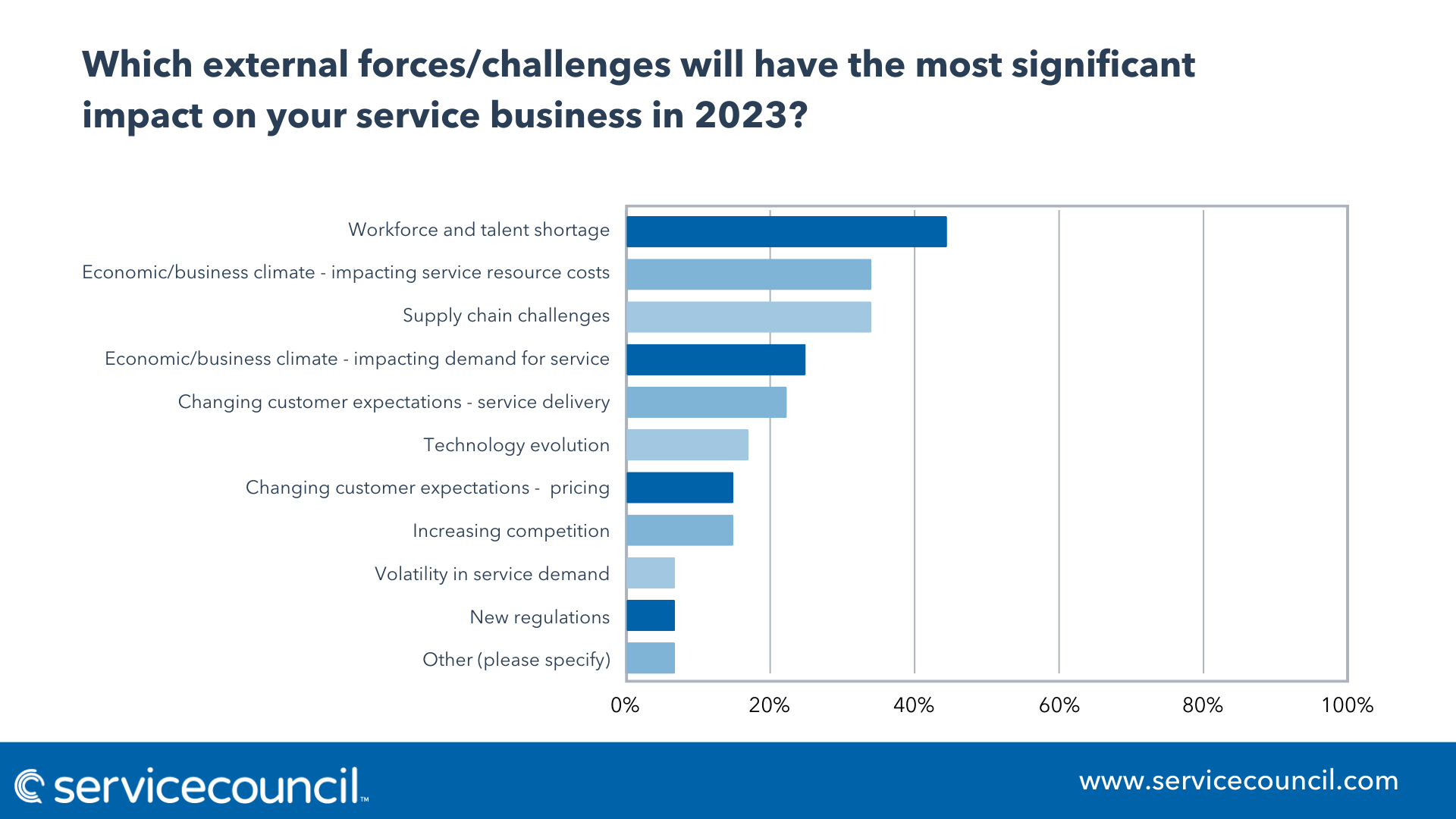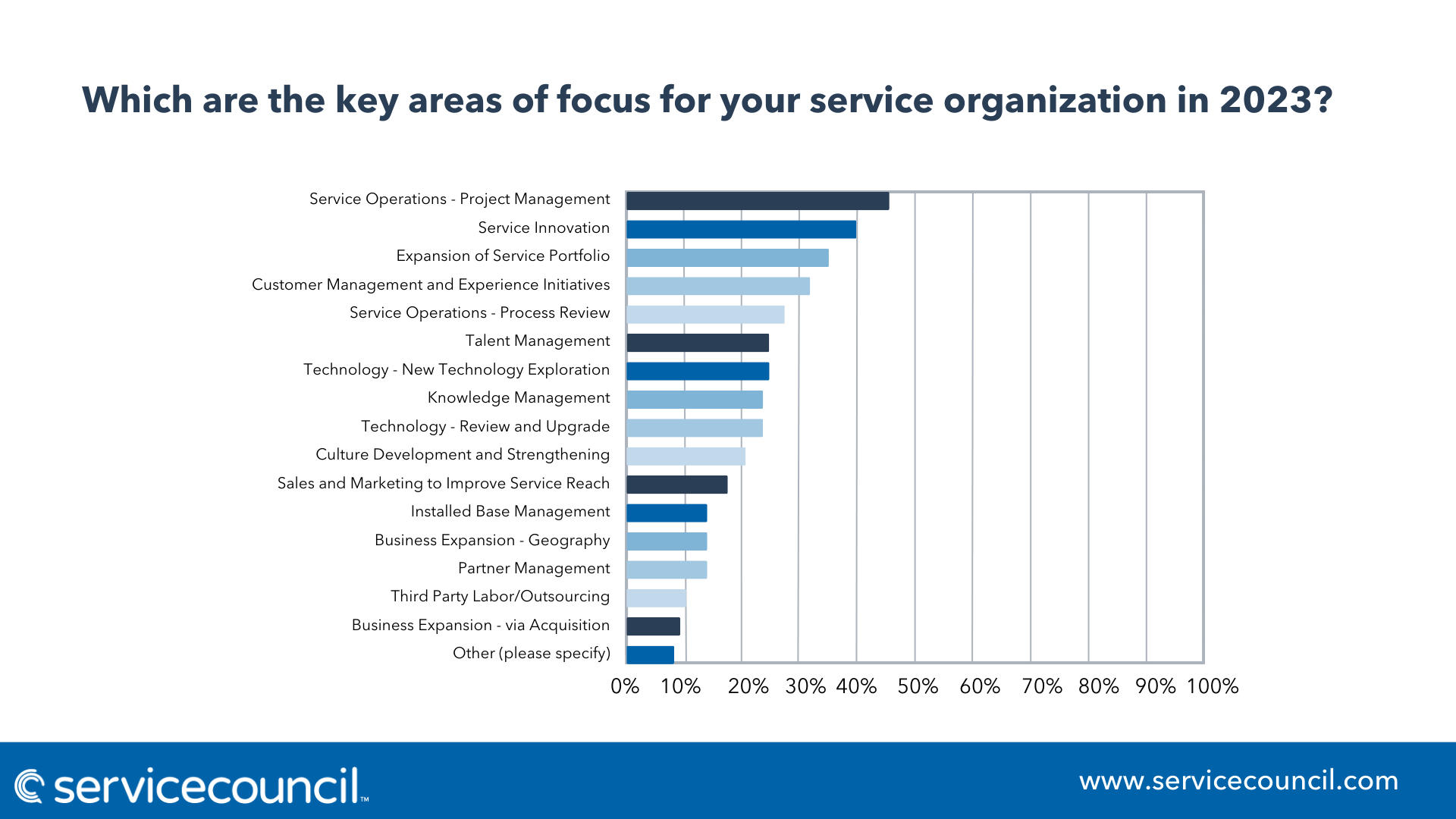As we continue through 2023, business leaders find themselves navigating a dynamic landscape shaped by macroeconomic challenges, including rising interest rates and inflation. Amidst these headwinds, service leaders face a unique set of obstacles, ranging from skill shortages and workforce quality issues to escalating costs and the lingering impact of supply chain disruptions. The Service Council and Convex have partnered to unpack these challenges and discuss opportunities to successfully traverse this complex environment (watch the Fireside Chat between CEOs Charlie Warren and John Carroll here).

Most service leaders agree that to achieve efficient growth in 2023, their organizations need to prioritize three key areas: Service Operations and Performance Management, Labor Management, and Revenue Innovation. Although each of these areas is more nuanced, a clear focus on these opportunities will set service leaders up to increase profitability, margin growth, and market share.

Service Operations and Performance Management
Service leaders must strike a delicate balance between service excellence and cost optimization. In 2023, most leaders are asking themselves, “how can I accomplish more with fewer resources?” The answer often lies in increasing the predictability of service delivery through better project management and process reviews. These practices help organizations gain better control over their service operations and cost structures through better route planning, more service field visits, and more profitable field visits.
Certain service offerings more efficiently improve the predictability of service operations. For example, many industry-leading organizations have benefited from shifting away from reactive, break-fix service models to pursuing more proactive and outcome-based solutions. Service models such as predictive service contracts, equipment inspections and certifications, and dashboard reporting capabilities empower service leaders to effectively plan service operations and control costs. Organizations can monitor performance remotely and proactively schedule visits, which helps an organization stay ahead of customer needs and drives customer satisfaction. Through these efforts, organizations can better plan field service visits, achieve more in each visit, and complete more site visits from each trip.
Furthermore, these innovative service solutions introduce more opportunities for add-on products and services that generate recurring, upsell, or cross-sell revenue opportunities. By proactively identifying and addressing customer needs through the improvement of performance and operations, leaders can improve customer satisfaction and gain a competitive edge in the market.
Labor Management
Commercial Service leaders are acutely aware of the importance of human capital amidst the ongoing talent war. The shortage of skilled workers presents a significant challenge for many service leaders, which is further exacerbated by aging demographic shifts in the workforce. As highly experienced workers retire, attracting, retaining, and developing talent becomes vital for maintaining service excellence and continuity. Successful service leaders are exploring various strategies to address these labor challenges, including investing in upskilling and reskilling programs, fostering a culture of continuous learning, and leveraging technology to automate routine tasks that hinder employee satisfaction.
Technology offers significant opportunities to improve a role, productivity, and the workplace, especially for younger generations. Using old or no technology will reduce employee satisfaction and drive employee churn over time. Moreover, successful usage of technology is known to drive significant lift against key performance indicators helping drive morale and job satisfaction. Thus, implementing modern workforce management practices offers service leaders opportunities to optimize resource allocation, reduce costs, and enhance employee engagement. By embracing innovative approaches to talent management, service leaders can build agile and resilient teams that meet the evolving demands of their customers and drive efficient growth.
Service Revenue Innovation
As service revenue is increasingly recognized as a critical profit driver for many organizations, many service leaders are reevaluating how they generate revenue. In fact, some organizations are leading a shift where aftermarket services have become the primary driver of profitability, outweighing profitability of traditional equipment sales. This changing landscape requires a fresh perspective and innovative thinking on how to avoid commoditization, package commercial offerings, and drive revenue forward with customer-centric solutions.
Some service organizations have successfully avoided commoditization by embracing emerging service models and shifting toward outcome-based solutions. These organizations are helping educate their customers, serving in a consultative manner, and providing reporting dashboards to empower the customer. However, only 44% of companies have achieved outcome-based service models and there’s significant room for improvement across the industry. By offering comprehensive service solutions that address specific customer needs, service leaders can differentiate themselves and create lasting value for their clients.
One compelling example of revenue innovation with an outcome-based approach, lies in the long-term partnership between Johnson Controls Inc. (JCI) and the University of North Dakota (UND). Leveraging JCI’s cutting-edge OpenBlue connected solutions, UND has transformed its facility management operations. Through remote monitoring, predictive maintenance, and energy optimization, JCI’s service offerings have helped UND achieve its energy targets, improve performance, and reduce operational costs. This innovative approach not only strengthens the relationship between JCI and UND but also showcases the immense potential of outcome-based revenue models.
Furthermore, forward-thinking service organizations capitalize on the convergence of technology and service offerings. With Internet of Things (IoT)-enabled equipment that seamlessly integrates within buildings, organizations can unlock additional revenue streams. These smart, connected solutions enhance efficiency, productivity, and customer experience, while generating incremental revenue for the service providers. Moreover, with effective customer database management and comprehensive market intelligence, sales organizations can identify untapped opportunities, target specific segments, and accelerate the sales cycle, ultimately driving revenue growth.
In the rapidly evolving service landscape, revenue innovation is not only a necessity but also a catalyst for sustainable business growth. By continuously adapting to customer demands, embracing emerging service models, and leveraging technology-driven solutions, service leaders can revolutionize their revenue generation strategies and secure a competitive advantage in the market. It is through these bold and innovative approaches that service organizations can thrive, exceed customer expectations, and propel themselves toward long-term success.
Navigating Challenges in 2023 and Beyond
In 2023, service leaders must proactively address the challenges of the macroeconomic environment, labor shortages, and supply chain disruptions. By prioritizing initiatives that improve service operations and performance management, labor management, and revenue innovation, service organizations can more effectively navigate these challenges and drive efficient growth. The Service Council remains a valuable resource for service leaders, offering research and insights that empower them to overcome obstacles and achieve success. Additionally, Convex partners with commercial service providers in order to transform how they find and win business.
Convex supports customers through our Commercial Services Platform, which provides powerful data, insights, and applications to help sales and marketing teams more impactfully plan go-to-market strategies, target key segments, and engage prospects. With our pipeline management solutions, teams can import or integrate their CRM data, discover leads, and track accounts and opportunities.
Share





